Since this device contains rechargeable batteries and Agilent makes instrumentation that can do battery drain analysis, I figured I would test the device using our equipment. I used an Agilent N6705B DC Power Analyzer loaded with an N6781A 2-Quadrant Source/Measure Unit (SMU) for Battery Drain Analysis. See Figure 2.
The product’s instruction sheet includes information about the batteries (700 mAH) and the expected battery run time when using the various features. With fully charged batteries, the expected battery run time for each of the features listed below is:
Given the battery amp-hour rating (700 mAH) and the expected run time in hours, we can calculate the approximate expected average current draw for each of the various features:
Using the N6781A SMU and the built-in front panel features of the N6705B DC Power Analyzer, I was able to analyzer the current drawn from the batteries when using each of the features. Each feature was used by itself with the other features turned off.
The flashlight draws a steady-state current that I read right from the front panel meter as shown in Figure 3: 50 mA. This agrees perfectly with the expected current draw I calculated. For this measurement and all subsequent current measurements, I connected the N6781A in series with the batteries and set it to Current Measure mode where it acts likes a zero-burden shunt. The measured current is negative in my setup because positive current is current flowing into the battery and with the flashlight on, current is flowing out of the battery.
For the flasher, since the current is not constant, I used the N6705B/N6781A built-in data logger feature and captured 30 seconds of data while the device was flashing. I then used the markers to measure the average current. Since the flasher flashes for a very short period of time (low duty cycle), I expected the average current to be low. When using the flasher, the expected battery run time seemed unusually short to me. At 10 to 12 hours, it is shorter than the flashlight or radio run time, which seems odd. In reality, as shown in Figure 4, the flasher drew very little current (5.6 mA), so it appears that the instruction sheet run time for the flasher is too low. With the device flashing, the battery will last much longer than indicated. In fact, the expected battery run time, when flashing, is about 700 mAH / 5.6 mA = 125 hours, 10 times longer than the time shown on the instruction sheet!- Flashlight: 12 to 16 hours
- Flasher: 10 to 12 hours
- Radio (low volume): 35 to 40 hours
- Flasher/siren: 6 to 9 hours
Given the battery amp-hour rating (700 mAH) and the expected run time in hours, we can calculate the approximate expected average current draw for each of the various features:
- Flashlight: 700 mAH / 14 hours = 50 mA
- Flasher: 700 mAH / 11 hours = 63.6 mA
- Radio: 700 mAH / 37.5 hours = 18.7 mA
- Flasher/siren: 700 mAH / 7.5 hours = 93 mA
Using the N6781A SMU and the built-in front panel features of the N6705B DC Power Analyzer, I was able to analyzer the current drawn from the batteries when using each of the features. Each feature was used by itself with the other features turned off.
The flashlight draws a steady-state current that I read right from the front panel meter as shown in Figure 3: 50 mA. This agrees perfectly with the expected current draw I calculated. For this measurement and all subsequent current measurements, I connected the N6781A in series with the batteries and set it to Current Measure mode where it acts likes a zero-burden shunt. The measured current is negative in my setup because positive current is current flowing into the battery and with the flashlight on, current is flowing out of the battery.
With the radio on, tuned to a station, and set to a low but audible volume, I once again used the data logger to capture the current. The markers show an average current of about 10 mA, which is less than the calculated value of 18.7 mA, but within reason. See Figure 5.
Using the flasher and siren, the data logger shows a current draw of 93 mA, in exact agreement with the expected current draw calculated from the numbers on the instruction sheet. See Figure 6.
The last current analysis I did was to capture 30 seconds of data logging when turning the self-charging crank to recharge the batteries. I purposely varied my cranking rate to see what would happen. Figure 7 shows an average of about 350 mA when turning the crank at what I considered to be a typical rate (highest average numbers on the captured data log). To fully charge 700 mAH batteries, it would take about 2 hours at that rate, which is in agreement with the instruction sheet (it says 2 to 3 hours). I don’t know about you, but I don’t want to turn that crank for 2 hours straight! Let’s hope I never have to use the tool for real, but I’m glad I have it just in case!
.jpg)

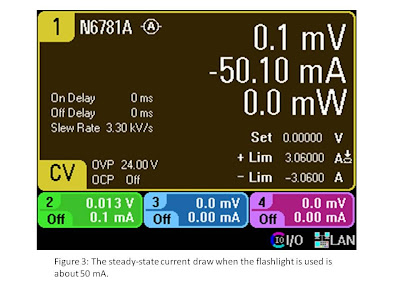.jpg)
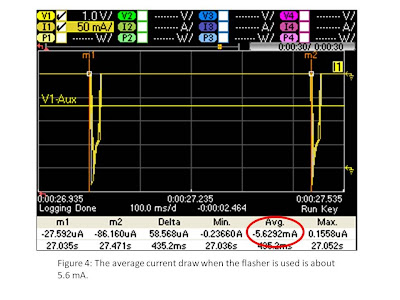.jpg)
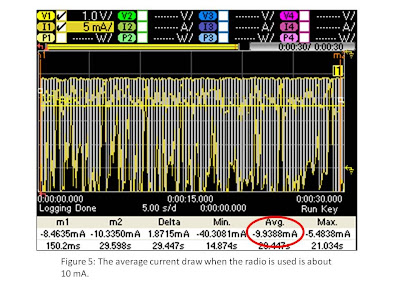.jpg)
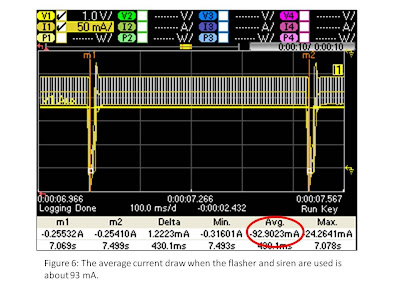.jpg)
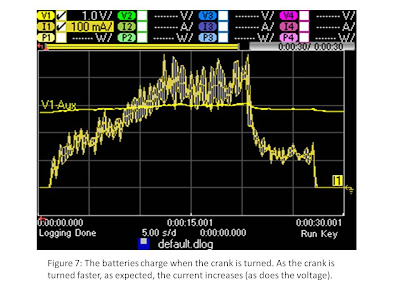.jpg)
No comments:
Post a Comment
Note: Only a member of this blog may post a comment.